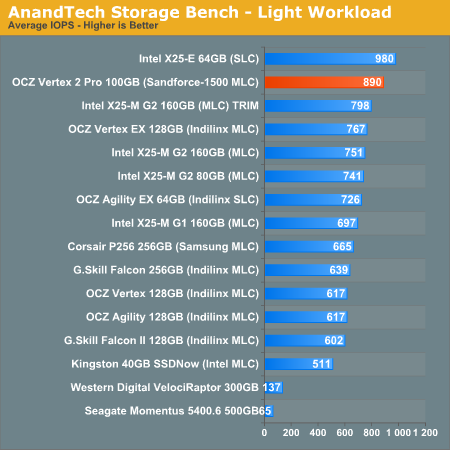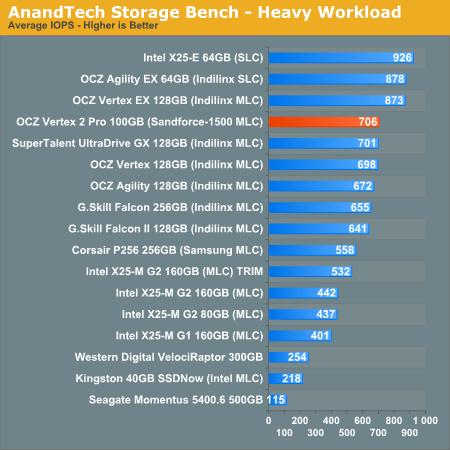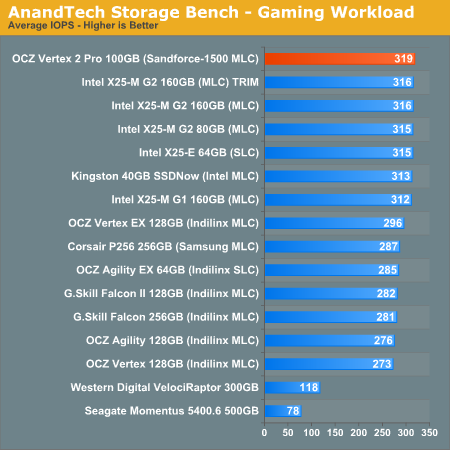OCZ's Vertex 2 Pro Preview: The Fastest MLC SSD We've Ever Tested
by Anand Lal Shimpi on December 31, 2009 12:00 AM EST- Posted in
- Storage
AnandTech Storage Bench
I introduced our storage suite in our last SSD article and it’s back, now with more data :)
Of the MLC SSDs represented here, there’s just nothing faster than the SandForce based OCZ Vertex 2 Pro.
Intel’s SLC based X25-E actually does very well, especially for a controller that’s as old as it is. It is worth noting however that the only thing separating Intel from SandForce-level performance is the X25-M’s low sequential write speed...
The first in our benchmark suite is a light usage case. The Windows 7 system is loaded with Firefox, Office 2007 and Adobe Reader among other applications. With Firefox we browse web pages like Facebook, AnandTech, Digg and other sites. Outlook is also running and we use it to check emails, create and send a message with a PDF attachment. Adobe Reader is used to view some PDFs. Excel 2007 is used to create a spreadsheet, graphs and save the document. The same goes for Word 2007. We open and step through a presentation in PowerPoint 2007 received as an email attachment before saving it to the desktop. Finally we watch a bit of a Firefly episode in Windows Media Player 11.
There’s some level of multitasking going on here but it’s not unreasonable by any means. Generally the application tasks proceed linearly, with the exception of things like web browsing which may happen in between one of the other tasks.
The recording is played back on all of our drives here today. Remember that we’re isolating disk performance, all we’re doing is playing back every single disk access that happened in that ~5 minute period of usage. The light workload is composed of 37,501 reads and 20,268 writes. Over 30% of the IOs are 4KB, 11% are 16KB, 22% are 32KB and approximately 13% are 64KB in size. Less than 30% of the operations are absolutely sequential in nature. Average queue depth is 6.09 IOs.
The performance results are reported in average I/O Operations per Second (IOPS):

If there’s a light usage case there’s bound to be a heavy one. In this test we have Microsoft Security Essentials running in the background with real time virus scanning enabled. We also perform a quick scan in the middle of the test. Firefox, Outlook, Excel, Word and Powerpoint are all used the same as they were in the light test. We add Photoshop CS4 to the mix, opening a bunch of 12MP images, editing them, then saving them as highly compressed JPGs for web publishing. Windows 7’s picture viewer is used to view a bunch of pictures on the hard drive. We use 7-zip to create and extract .7z archives. Downloading is also prominently featured in our heavy test; we download large files from the Internet during portions of the benchmark, as well as use uTorrent to grab a couple of torrents. Some of the applications in use are installed during the benchmark, Windows updates are also installed. Towards the end of the test we launch World of Warcraft, play for a few minutes, then delete the folder. This test also takes into account all of the disk accesses that happen while the OS is booting.
The benchmark is 22 minutes long and it consists of 128,895 read operations and 72,411 write operations. Roughly 44% of all IOs were sequential. Approximately 30% of all accesses were 4KB in size, 12% were 16KB in size, 14% were 32KB and 20% were 64KB. Average queue depth was 3.59.

Our final test focuses on actual gameplay in four 3D games: World of Warcraft, Batman: Arkham Asylum, FarCry 2 and Risen, in that order. The games are launched and played, altogether for a total of just under 30 minutes. The benchmark measures game load time, level load time, disk accesses from save games and normal data streaming during gameplay.
The gaming workload is made up of 75,206 read operations and only 4,592 write operations. Only 20% of the accesses are 4KB in size, nearly 40% are 64KB and 20% are 32KB. A whopping 69% of the IOs are sequential, meaning this is predominantly a sequential read benchmark. The average queue depth is 7.76 IOs.











100 Comments
View All Comments
Holly - Friday, January 1, 2010 - link
Well, you can patent implementation and technology, but not the idea itself. (At least that's what my boss was trying to explain me). So, in case this idea seems worthy enough other manufacturers will come with their own MySuperStoringTechnology (c).Personaly I think any improvement (even if it comes out to be dead end) is worth it in global scale and this tech seems very interesting to me.
I only have some worries about using cheaper NAND chips... Taking cheap USB flash they tend to go nuts in about 6-12 months of usage (well, I am stressing them quite a bit...) Putting them together with the best controller seems to me a bit like disbalancing things. Definitely not for servers/enthusiasts (who want the best quality for good reasons) and still too expensive for pple earning their paychecks
Holly - Friday, January 1, 2010 - link
P.S. Happy New Yearyacoub - Thursday, December 31, 2009 - link
I don't know that I want lower-quality Flash memory in my SSDs. I think I'd rather have both a better chip and high quality memory. But you know corners will be cut somewhere to keep the prices affordable.frontliner - Thursday, December 31, 2009 - link
Page 10 talks about Random Write in MB/s and you're talking IOPS:At 11K IOPS in my desktop 4KB random write test, the Vertex 2 Pro is 20% faster than Intel’s X25-M G2. Looking at it another way, the Vertex 2 Pro has 2.3x the 4KB random write performance of today’s OCZ Vertex Turbo.
&
Random read performance is quite good at 13K IOPS, but a little lower than Intel’s X25-M G2.
Anand Lal Shimpi - Thursday, December 31, 2009 - link
woops! you're right, I decided to go with the MB/s graphs at the last minute but wrote the text based on the IOPS results. Fixed! :)Take care,
Anand
Makaveli - Thursday, December 31, 2009 - link
My guess is intel will release another firmware to increase the write speed on the G2 drives. As Q4 2010 is quite a long wait for a refresh. So new firmware with increase write speed and a price drop should still keep them in the driving seat.Kudos to OCZ for the constant shove in the back to intel tho.
mikesown - Thursday, December 31, 2009 - link
Hi Anand,Great article! Along the subject of Intel's monopoly bullying, I was curious if you had any information about Micron manufacturing their own C300 SSDs with (very nice, it seems) Marvell controllers(see http://www.micronblogs.com/category/ssd-concepts/)">http://www.micronblogs.com/category/ssd-concepts/). I know Micron and Intel manufactured NAND jointly through their IM Flash Technologies venture, so it seems a little bit strange that Micron would manufacture competing SSDs while in a partnership with Intel. Did Intel and Micron part ways for good?
Thanks,
Mike
efficientD - Thursday, December 31, 2009 - link
As an employee of Micron, I can say that Intel and Micron have not parted ways, but rather only had the agreement for the actual flash memory and not all of the other parts of an SSD (controller, dtc.) We are still very much in cooperation on what was agreed upon in the first place. You will notice that the OCZ in this article is Micron, and not from IM flash (the Intel/Micron joint venture). If you crack open an Intel drive, however, you will nearly exclusively find IM Flash chips along with Micron DRAM, the first gen didn't even have Micron DRAM. Hope this clarifies some things.Doormat - Thursday, December 31, 2009 - link
I'm disappointed in the lack of SATA 6Gb/s support, but a lot of that is product timing (its only now showing up in add-on chips, and controllers in late 2010/early 2011). You really wonder what the speeds are on an unbridled SF-based drive.Jenoin - Thursday, December 31, 2009 - link
"SandForce states that a full install of Windows 7 + Office 2007 results in 25GB of writes to the host, yet only 11GB of writes are passed on to the drive. In other words, 25GBs of files are written and available on the SSD, but only 11GB of flash is actually occupied. Clearly it’s not bit-for-bit data storage.""What SF appears to be doing is some form of real-time compression on data sent to the drive."
Based on what they said (and what they didn't say) I have to disagree. It appears to me that they are comparing the write that is requested with the data already on the SSD and only writing to the bits that need changed thereby write amplification ~0.5. This would explain the high number of IOPS during your compressed file write test perhaps. That test would then be a mixed test of sequential and random writes giving you performance numbers in between the two other tests. Could you verify the actual disk usage with windows 7 and Office installed? If it indicates 11gb used then it is using some kind of compression but if it indicates the full size on the disk then it is using something similar to what I detailed. I just thought it interesting that Sandforce never said things would take up less space, (which would be a large selling point) they only said it would have to write about half as much supporting my theory.